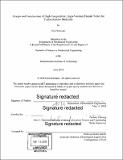Design and construction of high-temperature, high-vacuum tensile tester for fusion reactor materials
Author(s)
Nick Schwartz, Nick (Nick Raoul)
DownloadFull printable version (4.249Mb)
Other Contributors
Massachusetts Institute of Technology. Department of Mechanical Engineering.
Advisor
Zachary Hartwig.
Terms of use
Metadata
Show full item recordAbstract
Fusion energy is a promising carbon-free, limitless source of energy that could contribute to mitigating global climate change. One of the critical challenges in realizing fusion energy is the survival of structural materials in the extreme environment of a fusion device. Specifically, materials that surround the 100 million °C plasma must survive high temperatures (>500 °C), intense thermal cycling, transient high heat loads, large structural forces during off-normal plasma events, and exposure to high energy neutrons. Neutron exposure leads to high levels of radiation damage, which results in changes to critical material properties such as ductility and strength. In order to facilitate a better understanding of the effect of radiation on fusion material properties at high temperatures, a novel high-vacuum (<106 torr), high-temperature (<1000°C), tensile testing stand for irradiated specimens was designed and constructed. The test stand was designed to perform tensile testing of structural materials that have been irradiated by 12 MeV protons, which emulate the material response to high-energy neutrons produced in a deuterium-tritium burning fusion device. The specimen will then be heated to 500-1000 °C and tensile tested in high vacuum to eliminate sample oxidation and provide clean measurements. The design and fabrication of the test stand are given in this thesis, and first results from its commissioning are presented.
Description
Thesis: S.B., Massachusetts Institute of Technology, Department of Mechanical Engineering, 2018. Cataloged from PDF version of thesis. Includes bibliographical references (pages 24-25).
Date issued
2018Department
Massachusetts Institute of Technology. Department of Mechanical EngineeringPublisher
Massachusetts Institute of Technology
Keywords
Mechanical Engineering.